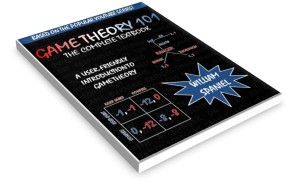Previously, we have looked at discrete type spaces. A person could have an ace, a king, a queen, or so forth, but there was nothing in between an ace and a king. Sometimes, a more natural way to think about incomplete information is through a continuum of types. For example, the value a country places on a disputed territory might range from anywhere between a small amount and a large amount.
This lecture introduces how to think about continuous type spaces. It represents a significant increase in technical complications. With continuous types, it becomes impossible to write a game matrix and solve for a Bayesian Nash equilibrium using the standard Nash equilibrium techniques. It also requires familiarity with probability density functions (PDFs) and cumulative distribution functions (CDFs), which are basic in probability theory but critical for describing the type space.
Takeaway Points
- A Bayesian Nash equilibrium requires a strategy for every type. Thus, the set of potential equilibrium is extremely complicated if there are infinitely many types of player.
- Fortunately, the equilibria in these types of games tend to follow a cutpoint rule. All types with a realized value below a particular cutpoint follow one strategy, and all types with a realized value above a particular cutpoint follow a different strategy.
- For intuition why cutpoint form equilibria, suppose the decision is whether to take an action at a cost for some benefit, and the uncertainty is over the cost. If a type with a higher cost is willing to take the action, then types with a lower cost must be as well. But if the cost becomes too high, then the better payoff in expectation is to not take the action.
- The key calculation is deriving the exact type that is indifferent between taking the action and not taking the action. Finding this type then gives clear instructions to what all higher and lower types should be doing.
- Cutpoint strategies are observationally similar to mixed strategies despite the fact that all but the indifferent type play pure strategies. An outsider would see a player sometimes take one action and sometimes take the other action. With a mixed strategy Nash equilibrium, this randomness is coming from the player’s endogenous strategy choice. With a Bayesian Nash equilibrium, this randomness is coming from Nature’s exogenous draw of type.

